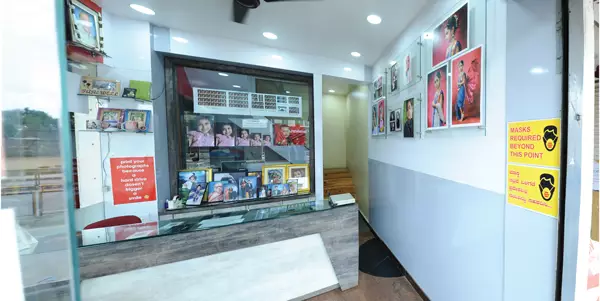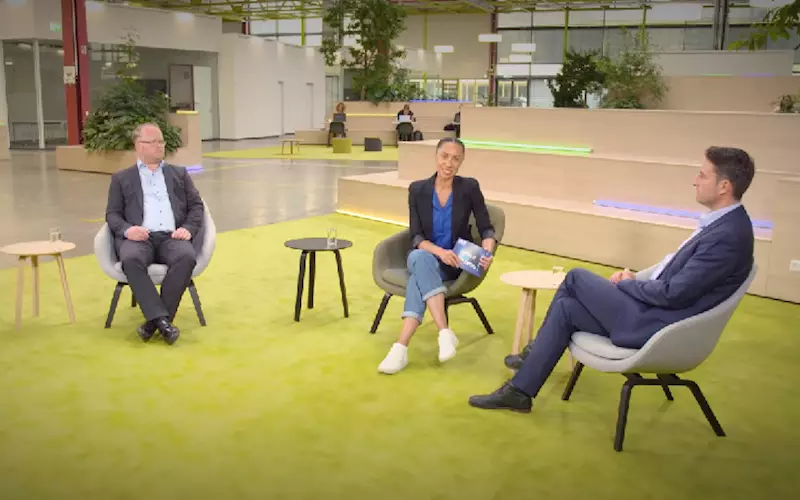Day three of Heidelberg Innovation Week: Mastering complexities in label printing
Print runs are decreasing, delivery times are getting shorter - and all this with customised customer requirements, which includes sustainability. How can this complex mix of requirements be balanced? Which innovations ensure an increase in performance? And what are the pre-requisites for flexible and efficient label production with maximum automation?
22 Oct 2020 | By Charmiane Alexander
These topics were discussed on the third day of the Heidelberg Innovation Week. The discussion was hosted by Yasmine Blair with Philipp Doley, product manager, business development label and Jochen Pecht, product manager, business development manager, on the panel.
Yasmine Blair (YB): Let’s start with a fundamental question. What makes the field of label printing so very attractive for so many printing companies?
Philipp Doley (PD): The label market itself, the label business is a very stable business, it's a growing business. We do not only see this in Germany, where we are located. In fact we see it everywhere in the world. We see higher growth in many markets, like South America or in Asia. That's why a lot of print shops are focusing on this segment.
YB: Even during Covid-19?
PD: This business was not really affected by Covid-19. During Covid-19 too, the print shops had enough work to produce. And this was good to see. From our side, we do not only sell machines, we also deliver the know-how to our customers.

YB: It's great to hear that you weren't struck by the Covid-19 crisis. The orders in label printing are getting more and more complex even as the print runs are dropping. Why so? How do you explain that?
PD: If you go to a supermarket, and have a look into the fridge, and look at a fresh cheese product. Ten or 15 years ago, there were two to four different fresh cheese products. Now you see twenty types of cheese with different tastes or organic, standard, low fat and so on. So, you see that the SKUs have gone up, but the quantity of orders has reduced. There are no big volumes of a single kind of cheese, because they need to stock all types to meet the different tastes of customers. Hence these orders are in smaller volumes, more often. From a label converters perspective, these different SKUs make for complex production handling.
YB: You often speak of trends or one certain trend is high gloss metallic effects that increase the value of packaging. Please explain what are the advantages or what are the advantages of cold foil?
Jochen Pecht: You can apply cold foil inline - and efficiently on materials like paper or board or thin plastic films even and if you have this silver aluminum layer you can overprint with four process colours or special colours. So you can achieve any metallic colour you want like green metallic, red metallic or even blue metallic. You can also apply a special coating of cold foil, if you want to have a haptic effect. For example, you can apply a soft touch coating. Or if you want to apply more visual effects to that you can apply a matte coating or even a gloss coating. All this is possible.
YB: When applying cold foil, you're in a stable production, how can you ensure that it's actually going to work well and work properly on in-mould materials? What's the trick?
JP: Well, we had a closer look about this application. And we had to redesign our web guidance. And we call that new web guidance as Foilstar Cure. What we did is, we took a longer wrap of the cold foil over the impression cylinder. And on that point, we have a composite of substrate, the UV glue, and the cold foil and we cure this composite with our DryStar LED which is poured in the dryer. Now we have a very high gloss, cold foil surface. It’s a stable process for production of IML labels.
This label can be used for label application aimed not only at the food market, but also for the non-food market.
YB: A complicated or challenging process, this production of in-mold. How can this thin material be handled during the production process? What do you need to keep an eye on?
PD: Our machines are built to run a wide range of substrates. So we can run 30 micron material up to one millimeter on a standard machine. But for this special product like the IML, we do have very special modules, and components integrated into the procurement. We have the substrate packaging, where you can order foils, and a brand new IML performance package. You have different components in the machine – from the feeder to the printing unit, the sheets travel to the delivery. Our new CutStar version, the kit that converts reels into sheets prior to entering the feeder, is a completely new platform, newly designed to increase productivity of our customers. It’s a debut kit at the Innovation Week.

YB: If we look at Heidelberg history, there’s years of experience. How would your customers benefit from this complete package of know-how that you bring along at Heidelberg?
JP: Well, a very high level of know-how is already integrated in our presses. Our assistance systems and the press are getting more and more intelligent and help the operator to work through those jobs making presses more efficient and productive.
But that's not all. We also consult our customers for their application questions or we consult them in the direction of special press configurations. Our Print Media Academy, for example, is offering operator training and our Saphira consumables portfolio is very specialised for label printing – all that to make our customers profitable. We have a good partnership. And we should be in a win-win situation.
YB: How do we avoid bottlenecks? How can they be avoided in post-press work? If production on the presses are at such a high speed and there's such a high volume of production, what do we do?
PD: This is not a new question for us. We've faced this question in 2005. At that time, our customers had flatbed die-cutters in the production area running at a very low speed.
So, we decided to fix the problem. Our R&D led to the XL 106 DD, the rotary die-cutting machine. That was a very successful machine. We already have more than 60 machines in the market producing IML labels in different variations. It was an inline machine directly integrated in the printing machine – in conventional mode or in UV mode. We had our special magnetic cylinder with an extraction device for extracting very small holes – injection holes, for example.
Now we have a new version of our XL 106 D rotary die-cutting machine. This is a one unit machine. We built this machine to reduce the footprint in the area of the post press and also decrease the price of the machine. After this rotary die cutting process, we work together with our partner Kawahara. They have a very special punching machine to blank out and cut labels. This is one side of the production. On the other side, you can also work with the Polar system, our other partner. Polar has a counter-pressure device very special for IML as well.
YB: If one of your clients says, I would like to enter the in-mold segment right away? What are the different possibilities to enter this market segment?
JP: For Heidelberg customers, it's very easy to step into this segment. They can easily use the existing machines for example, the Speedmaster XL 75 or CX 102, which can print on very thin material.
Also, those customers who are doing commercial work on the XL 106, eight-colour press, four over four. They can easily fill up the vacant capacity by producing labels. All they have to do is retrofit our thin substrate package or our foil substrate package for a better performance. But if the jobs are growing and if the demand of volume is getting more and more, we offer our peak performance machine, the XL106 together with our brand new CutStar and with our full package with our substrate package, and the IML performance package for highest production speeds. We also offer conventional inks and coatings.

YB: The last question is for Phil. We've already spoken about trends. If we have a look at future trends, which direction do you think we're heading towards in terms of development? We would like to have a close look at sustainability, what do you think will be coming up in these next generations of in-mold.
PD: I think, the film suppliers need to produce or develop substrates that meet the market demands or the consumer trends. For example, if you have a product in the fridge, and the consumer handles the package, the feeling has to be nice. So, the tactile quotient has to be high.
I am sure the film suppliers are studying this for sure. Recycling is a big issue. The film companies can look at the waste in their production process and maybe recycle the waste to produce new products.
What we see is the substrates are getting thinner and thinner. So if we looked back 10 years ago, the standard thickness was 70 microns, we still have them. But from 70 microns, it has come down to 50. Today 50 microns is the standard. We are also seeing some customers production labels and packaging with 40 micron films.
However, there are regulations from the government from time to time. So, if the government says you need to apply 20% of recycled material inside of your packaging, then you will need to look to the entire chain of production.











 See All
See All